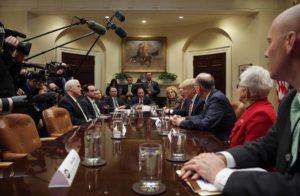Work on reform has been non-stop on the staff level. This is not the kind of exciting work that will make the headlines of the Wall Street Journal or even in tax trade publications.
It’s happening in offices and conference rooms on the Hill where tax-writing staff are floating ideas, meeting with industry groups and putting meat on the bones of a “United” House, Senate, White House (WH) tax reform framework.
Yes. United.
In an attempt to avoid dealing with a different bill from each house and an expansive proposal from the WH, which would then go to conference to be hashed out (some of us like to call this “standard procedure”) by the big 6.
Who have been meeting since March to come up with broad factors they can reach agreement on- a territorial system, tax cuts as low as possible for as many as possible, and as much permanence of these provisions as possible.
Not an easy task no matter how you slice it, but the very specific expedited procedural process they need to use-reconciliation, where only 51 votes are needed to pass the Senate, hamstrings them.
 However, with the advantages of only needing a simple majority to vote yes, comes strict boundaries to follow, which will make this a very delicate acrobatic endeavor, even with a Republican Majority.
However, with the advantages of only needing a simple majority to vote yes, comes strict boundaries to follow, which will make this a very delicate acrobatic endeavor, even with a Republican Majority.
As Congress returned after Labor Day, Federal Tax-writing staff barely had a break and have been working furiously, so when its floor time for them, they have a bill that is “baked.”
House, Senate and WH Republicans all working together to come up with one tax reform proposal.
The process is firmly now with the tax-writing committees– with the NEC and Treasury tax staff in constant touch –hammering out details that will transform the broad Republican framework into specific legislative provisions.
They will need 51 votes to pass this on the Senate Floor. Senate Committee staff and members are deeply involved in drafting. On the House side, the Ways and Means staff are carrying the load at first, and will present the “meat” to members in the next few weeks.
But everyone’s work is based on the big 6 framework. And they are welcoming input from industry groups to guide them on hits path.
Not a slam-dunk, even with a Republican Majority and VP Pence as a tiebreaker.
 I actually have faith that staff will come up with some solid and unusual ways to (1) put a bill together that reforms as much as the tax code as possible, (2) gives at least some tax relief to all Americans and businesses, and (3) makes at least some provisions permanent.
I actually have faith that staff will come up with some solid and unusual ways to (1) put a bill together that reforms as much as the tax code as possible, (2) gives at least some tax relief to all Americans and businesses, and (3) makes at least some provisions permanent.
They actually may garner enough votes in the Senate. Republican leadership staff will have to be extremely deft and nuanced as they procedurally escort this bill to passage.
They may have to be so flexible that their feet can go behind their head.
However, if that house of cards can pass the Senate, I’m not so sure that bill can pass the House. Speaker Paul Ryan will have his toughest test yet of herding cats to get it done. And, if its even somewhat within the President’s goals he will likely sign it.
So can they get the votes? I think the answer is yes.
However (you knew that was coming), given a very full legislative agenda, especially of items that have to get passed IN ORDER to even get to tax reform (debt limit, budget resolution, reconciliation instructions and Harvey assistance).
WHEN is the big question about tax reform.
The Freedom Caucus has been saying it has to be by Thanksgiving.
That’s nice.
Tax staff, while trying as hard as possible to get something done by end of December to score a win, are saying that practically speaking, anything they can do prior to the next election (2018) is a win for Republicans.
You are not going to read that in a newspaper or tax trade press.
No Republican elected official will say it out loud, but practically speaking, there is NOT a path to tax reform “as the crow flies.”
There are a few wicked, twisted circuitous paths that can get them there. Tax writers of both houses and the administration are smart, creative people.
With enough time and tweaks and acrobatics to stay within certain rules-they can do it.
Time in 2017 is not on their side, however and the budget resolution may not be on their side either.
Another potential speed bump exists.
If current policy baseline is used in a Senate Budget Resolution, it certainly increases the chances of a tax reform bill sooner than later-but not soon enough for the President or leadership who want a “win” by the end of this year.
The end of this year –Congressionally, even politically speaking is not really that different than August 2018 as a target. So, I think it’s “when,” not if.

